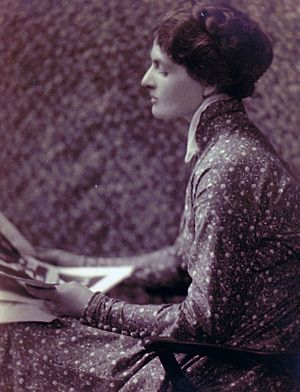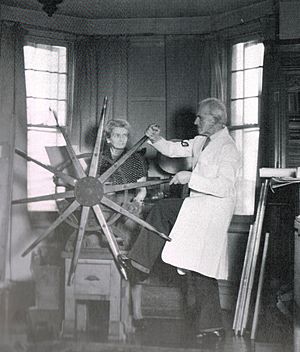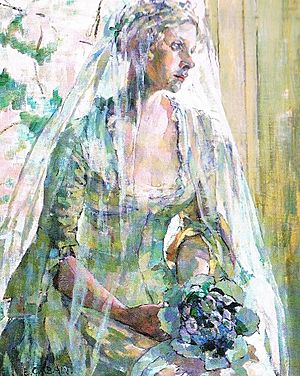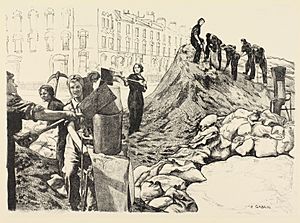Ethel Léontine Gabain facts for kids
Quick facts for kids
Ethel Léontine Gabain
|
|
|---|---|

Portrait of Ethel Gabain - Private Collection
|
|
| Born |
Ethel Léontine Gabain
26 March 1883 Le Havre, France
|
| Died | 30 January 1950 (aged 66) London, England
|
| Nationality | French |
| Education |
|
| Known for | Painting & lithography |
| Spouse(s) | John Copley |
Ethel Léontine Gabain, later known as Ethel Copley, was a talented French-Scottish artist (born March 26, 1883 – died January 30, 1950). She was famous for her paintings and especially for her lithographs, which are a type of printmaking. Ethel was one of the people who helped start the Senefelder Club, a group for artists who made lithographs.
While she painted many oil portraits of famous actresses, Ethel Gabain was special because she could make a living just by selling her lithographs. She also created etchings, dry-points, and even some posters.
Contents
Ethel Gabain's Life Story
Growing Up and Art School
Ethel Gabain had four sisters and one brother. Her father was French, and her mother was Scottish. Her father, Charles Edward Gabain, was a wealthy coffee importer. When he retired, his family moved to England.
Ethel was born in France and lived there for over 20 years. She was ready for life in England because she had attended Wycombe Abbey School in Buckinghamshire from age 14. This school helped her art skills grow. They even asked her to paint a portrait of their headmistress, Miss Ann Watt Whitelaw.
In 1902, Ethel studied art at the Slade School of Fine Art in London. The next year, she went back to France to study in Paris. From 1904 to 1906, she studied at the Central School of Arts and Crafts in London. There, an artist named F. E. Jackson taught her how to make lithographs.
The Central School taught artistic trades like lithography. Ethel was determined to make her own prints. She also learned how to use a printing press at the Chelsea Polytechnic. She tried making color lithographs but decided she preferred rich, brilliant black and white ones.
Starting the Senefelder Club
In 1910, Ethel Gabain, her future husband John Copley, and other artists like A.S Hartrick and Joseph Pennell helped create the Senefelder Club. This club was for artists who made lithographs.
When the club had its first art show in January 1910, six of Ethel Gabain's lithographs were shown. Later, in 1927, the club's artists showed their work at a big exhibition in the Louvre museum in Paris. In 1929, her art was featured in a British art show in Sweden.
Ethel and John Copley got married in 1913. They lived in Kent for a while. Ethel would often add a tiny picture of a yew tree to her prints during this time. She also used images of their home, like pergolas and a sundial, in her artwork.
The couple and their two sons, Peter and Christopher, later moved to London. Ethel had her art studio on the top floor, and John had a printing press. They often worked together. In 1925, John became very ill, so the family moved to Alassio, Italy. For two and a half years, Ethel painted the beautiful landscapes there. She also taught art classes and gave public talks at the Alassio English School.
Art with a Thoughtful Mood
When Ethel lived and worked in Paris, she started creating art about "melancholic young females." These were pictures of lonely young women. She returned to this idea later in her career, making several images of a sad young bride.
Ethel's favorite model for these pictures was Carmen Watson. By the time Carmen got married in 1940, she had posed for Ethel over 60 times! Ethel met Harold J. L. Wright, a publisher, because he saw one of her lithographs called The Striped Petticoat. He liked it so much that his company, Colnaghi and Co, became her publishers. They became lifelong friends.
Ethel also explored thoughtful themes with characters like Pierrot and Columbine. Pierrot is a sad clown who loves Columbine, a beautiful ballet dancer. Ethel loved ballet and created many artworks of young ballet dancers.
Illustrating Books
In 1922, a French art collector named Monsieur Edmond Paix asked Ethel to create 22 lithographs for a special edition of the book Jane Eyre. He had seen her lithograph The Striped Petticoat and loved her style. Her illustrations included a ghostly image of Jane Eyre.
In 1924, Ethel Gabain was asked to create nine lithographs for the book The Warden by Anthony Trollope. This book was published in 1926.
Switching to Oil Paintings
Because the market for prints slowed down, Ethel started painting with oils to earn more money. Her first oil painting, Zinnias, was shown at the Royal Academy in 1927 and was very popular. She also painted landscapes and portraits of famous actresses in their stage roles. These included Peggy Ashcroft, Edith Evans, and Flora Robson.
In 1932, she became a member of the Royal Society of British Artists. The next year, she joined the Royal Institute of Oil Painters. Also in 1933, her portrait of Flora Robson won a special medal. Ethel also showed her art with other groups like the Artists' International Association. To earn extra money, she sometimes gave talks about art history. In 1940, she became the President of the Society of Women Artists.
Art During World War II
In April 1940, the War Artists' Advisory Committee (WAAC) asked Ethel Gabain to create art about the war. They wanted four lithographs of Women's Voluntary Services members and four about children being evacuated from cities. Ethel offered 13 lithographs, but WAAC only accepted the eight they had asked for.
WAAC published these as two sets: Children in Wartime (five images) and Women's Work in the War other than the Services (six images). In total, WAAC bought 38 of Ethel's artworks during the war. Even though she was often not well, Ethel traveled all over Britain for these projects.
She went to the Scottish Highlands to draw "lumberjills" (women who cut down trees) at a Women's Land Army camp. She also went to Devon to draw children who had been evacuated from London. Throughout the war, Ethel showed women working in jobs that men usually did before the war. She drew women doing salvage work, factory workers, and air raid wardens. She also painted a portrait of Captain Pauline Gower of the Air Transport Auxiliary. In 1945, she painted portraits of important women like Barbara Ward and Caroline Haslett.
Ethel's war commissions also let her explore new medical ideas. In 1944, she drew Sir Alexander Fleming working in his lab where he discovered penicillin. She also drew A Child Bomb-Victim Receiving Penicillin Treatment, showing a young girl getting the medicine. She recorded new ways of treating burn victims.
Several companies also asked Ethel to create art for them. Williams and Williams in Chester asked her to make lithographs and oil paintings. One painting shows Women Workers in the Canteen at Williams and Williams. She also received commissions from Ferranti Hollinwood, Richard Haworth & Co. Ltd., and the British Cotton Industry Research Association.
Later Years and Legacy
In 1939, Ethel Gabain became very ill. Although she got a little better, her health remained poor. She suffered from arthritis and even lost a kidney, but she kept painting and showing her art until her last months. Her artwork was also part of the art competition at the 1948 Summer Olympics.
Ethel Gabain passed away on January 30, 1950, at her home in London. After she died, her husband, John, organized a special exhibition of her paintings and lithographs to honor her work.
Artistic Groups and Memberships
Ethel Gabain was part of several important art organizations:
- 1909: She was a founding member of the Senefelder Club.
- 1925: She became a member of the Society of Graphic Art.
- 1932: She joined the Royal Society of British Artists.
- 1933: She became a member of the Royal Institute of Oil Painters.
- 1934: She was the Vice-president of the Society of Women Artists.
- 1940: She became the President of the Society of Women Artists.






